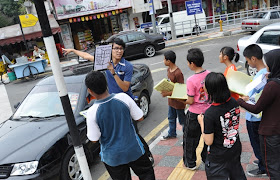A final briefing on the protocols of entering a place of worship....
...and then we reach our destination.
The basic rules about entering the Gurdwara are clearly displayed.
This is also my first time visiting a Gurdwara, I was definitely excited.
Fahmi had made prior arrangements and we were met my one of the priests at the Gurdwara.
A head scarf is provided for those of us who needed it - heads must be covered for those entering a Gurdwara.
In the top photo, the Senior Priest is helping one of the children with his scarf, in the bottom photo, it's Fahmi who's doing the honors.
I wondered about the taps, similar to those found at Masjids, that were available at the entrance of the Gurdwara. We are to wash our hands and feet before entering.
On the way to the main prayer hall, we passed some smaller halls which we were informed are used to hold smaller functions.
Even in the smaller hall, there is the 'alter' holding the Guru Granth Sahib, the Sikh holy scripture.
The main hall is huge. This is said to be the largest Gurdwara in South East Asia. Traditionally, ladies and gentlemen sit on their respective sides of the hall.
Directly opposite the entrance, at the far end, is the Guru Granth Sahib.
We were witnesses to the reading of the Guru Granth Sahib by the Chief Priest - it will be the next and last post in the Chow Kit Kita series.
This is a view of the outer corridor of the main prayer hall.
The prayer hall is generally bare but this framed image of the Khanda did catch my attention.
The Khanda is one of the most important symbols of Sikhism and is commonly found on the flag of the Sikhs.
It contains a double-edged sword, a Khanda, in the centre representing knowledge of God. The circular Chakkar represents the eternal nature of God and oneness of humanity. It also means there is only one God, never beginning and never ending. The two single-edged swords, Kirpans, represent Miri, temporal power or political sovereignty, and Piri, spiritual sovereignty.
Source: Wikipedia














No comments:
Post a Comment